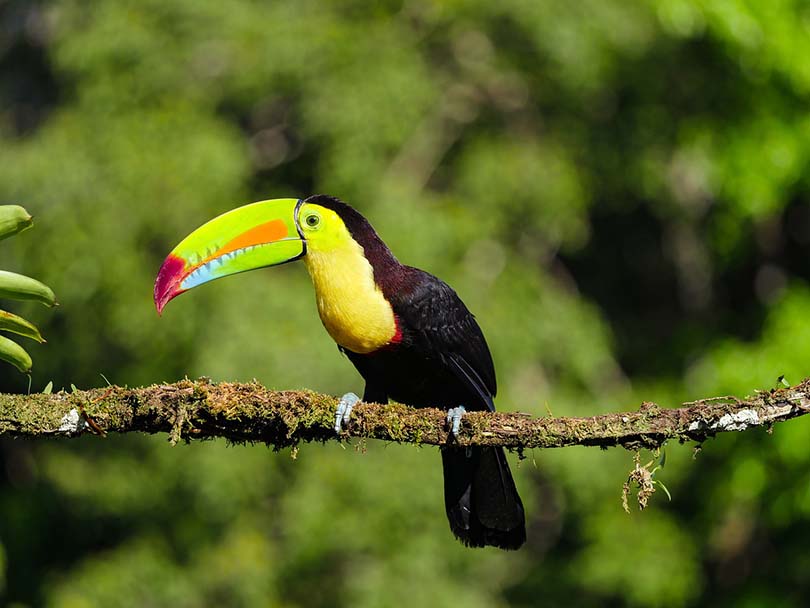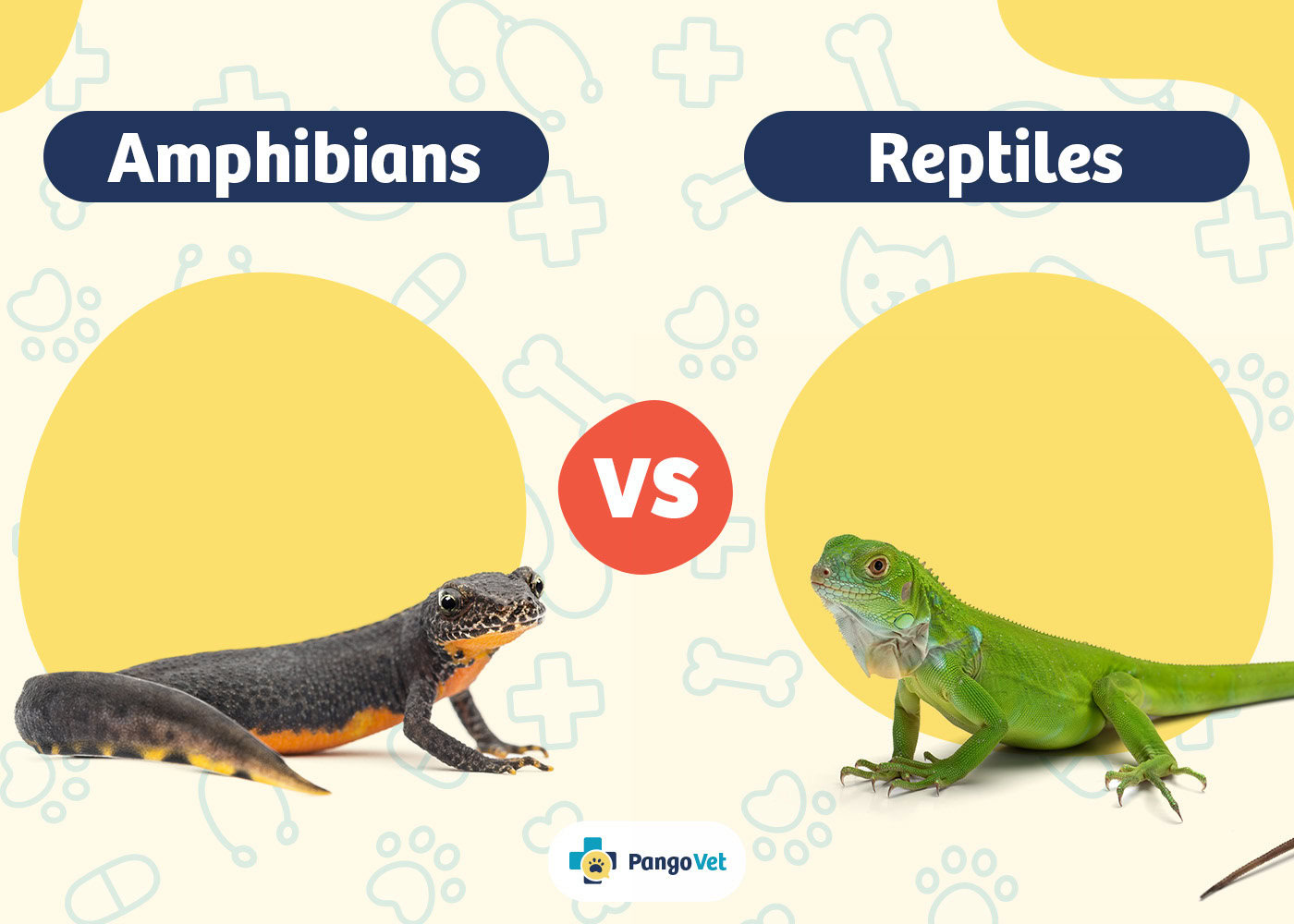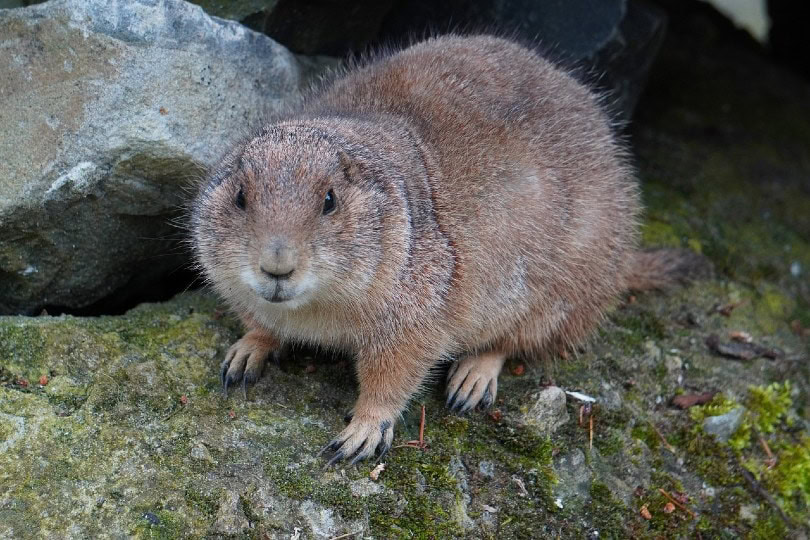Click to Skip Ahead
If you ate Froot Loops and watched “Paulie” or “Rio” as a kid, the magnificent birds that are toucans and parrots are likely to have marked your childhood. These charismatic creatures are indeed beautiful representatives of the class Aves, but in addition to being colorful, are these birds related?
Technically, no: Toucans are members of the Ramphastidae family, and their closest relatives are American barbets. Parrots are part of a large order (Psittaciformes) that includes more than 350 species; for example, macaws, cockatoos, and parakeets are all considered “parrots.”
Read on to find out the other main differences (and similarities) between these birds.

Quick Facts About Parrots and Toucans
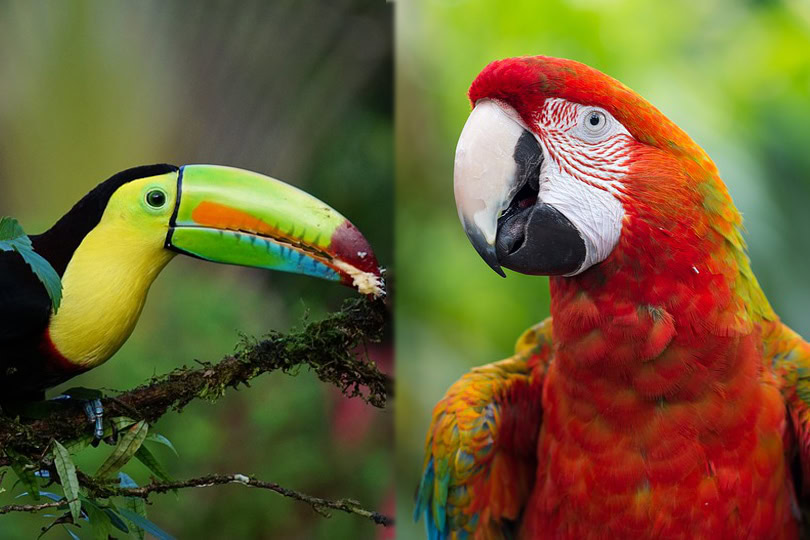
| Common Name: | Parrot | Toucan |
| Scientific Name: | Psittaciformes | Piciformes |
| Family: | Three superfamilies: Cacatuoidea (cockatoos), Psittacidae (true parrots), Strigopoidea (New Zealand parrots) | Ramphastidae |
| Lifespan: | Up to 80 years | Up to 20 years |
| Size: | 3.5 inches to 40 inches | 11 inches to 25 inches |
| Weight: | 2.25 ounces to 3.5 pounds | 4.5 ounces to 1.5 pounds |
| Diet: | Omnivorous | Frugivorous, omnivorous |
| Distribution: | Oceania, South Asia, Southeast Asia, Central America, South America, and Africa | Southern Mexico, Central America, South America |
| Habitat: | Warm climates | Tropics, rainforests |
Parrot Overview
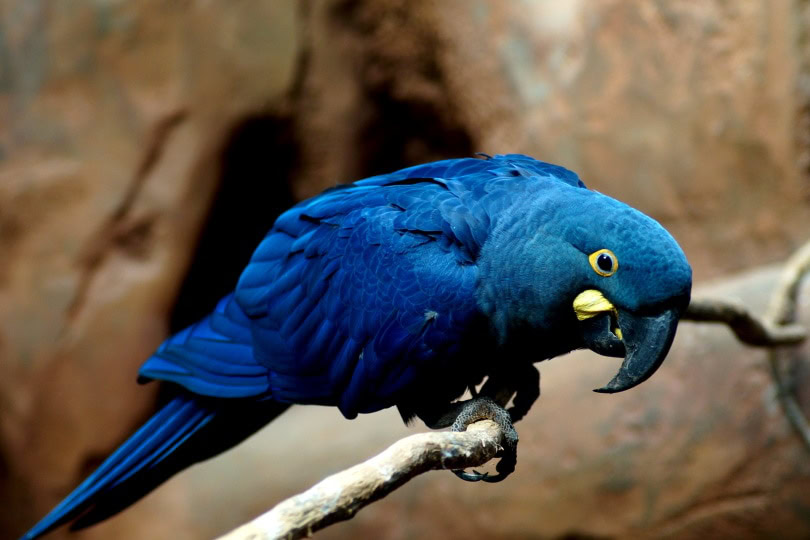
“Parrot” refers to several species of the order Psittaciformes. Generally, these birds have large, hooked beaks and bright colors and are good at imitating sounds.
They are divided into three superfamilies:
- Cacatuoidea (cockatoos)
- Psittacidae (true parrots)
- Strigopoidea (New Zealand parrots)
Most parrots are part of the family Psittacidae, which includes parakeets and parrotlets. These birds are also known for their ability to speak, which is highly developed in some species. This is mainly why people love to keep parrots as pets.
Toucan Overview
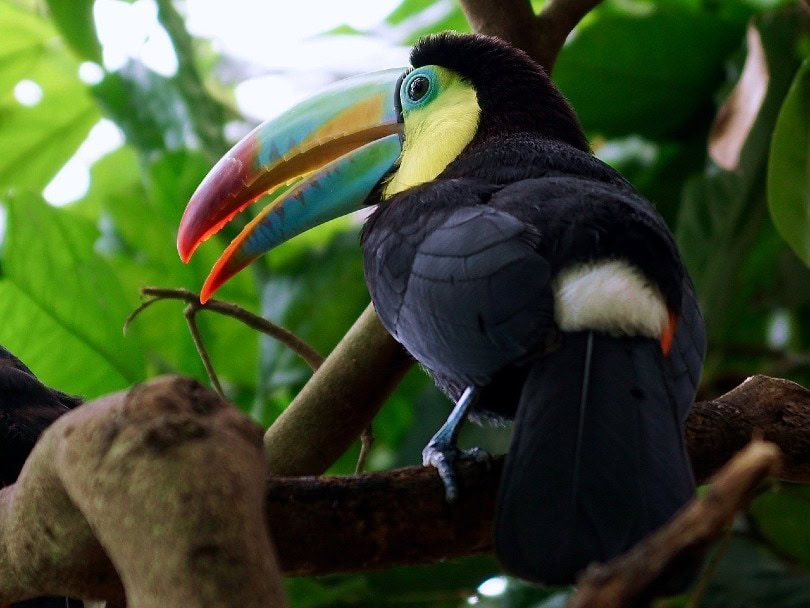
Toucan is the common name for the birds of the Ramphastidae family in the order Piciformes. They are medium-sized climbing birds with huge, vividly colored beaks, which enable them to regulate their temperature. They also have a long tongue that helps them eat fruits and seeds. Toucans are found mainly in the Amazon rainforest.

What Are the Differences Between Parrots and Toucans?
Habitat
Parrots are distributed all over the world; they can be found in tropical and subtropical regions, such as Australia, South Asia, Southeast Asia, Central America, South America, and Africa.
Toucans are mainly located in South America and Central America. They thrive in hot, humid climates and rainforests.
Temperament
Although there are some differences between the 40 species of toucans, they are generally not shy birds. For example, the toco toucan, the largest and most famous of the toucans (the proud representative of Froot Loops, Sam, is a toco!) may go so far as to enter houses to steal food!
However, compared to parrots, toucans are not particularly gregarious animals. They prefer to fly in dispersed groups, one after another, rather than in compact flocks. Moreover, it is rare to find more than one individual per cage in captivity, given that they are solitary and territorial. Parrots prefer to live with their peers, and some species will even starve to death if left on their own in their cage.
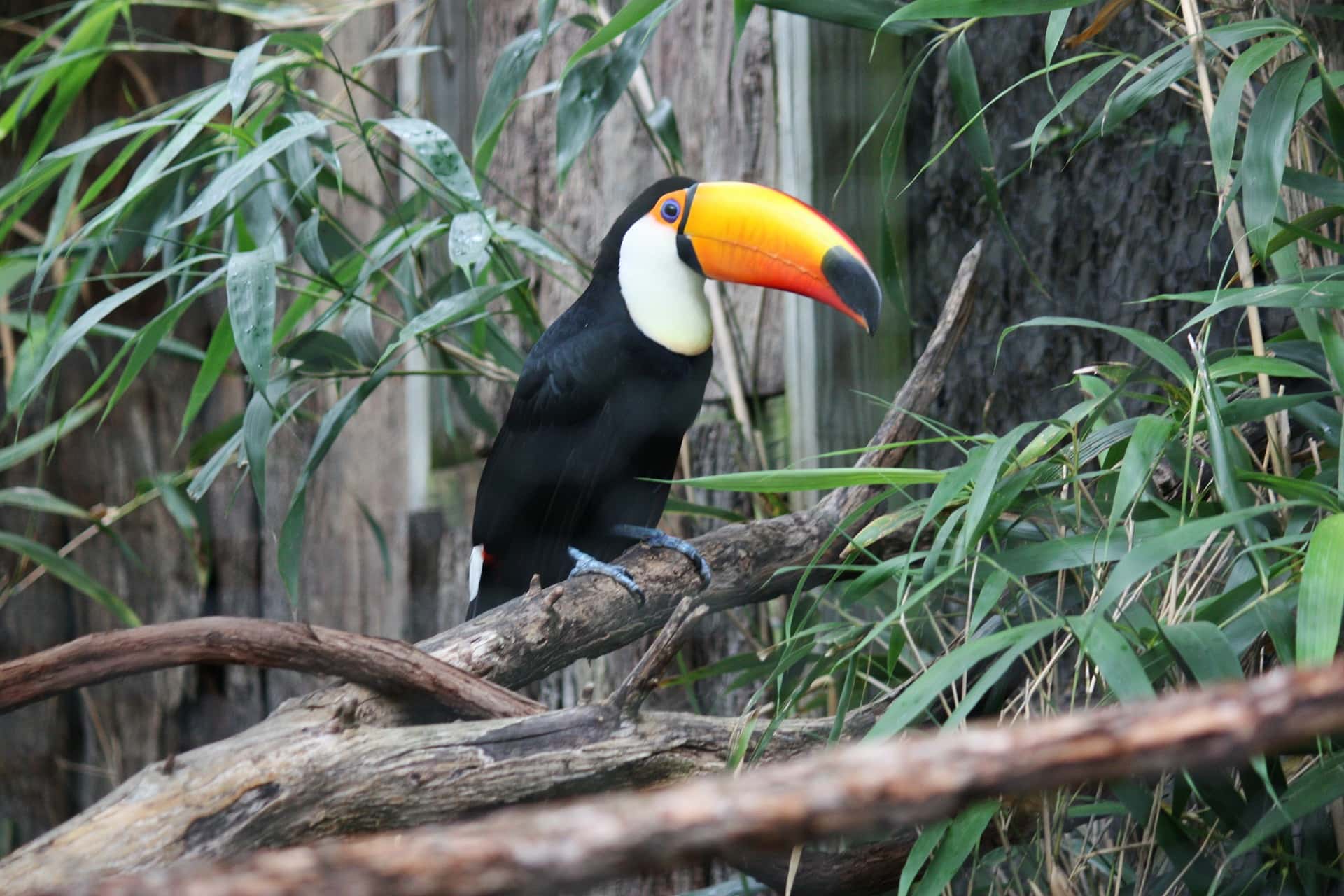
Diet
Toucans are frugivorous birds, which means they mainly eat fruit. In the wild, they will also consume small lizards, insects, eggs of other birds, and even young birds. They use their beaks like pincers to grab their food. In addition, they do not consume a lot of water, as they get the fluids that they need from the fruits they eat.
One of the morphological peculiarities of the toucan is that they do not have a crop, which is an organ of the digestive system that many bird use to store large portions of food before digestion.Therefore, toucans cannot digest seeds like parrots can. Their stomachs are also much smaller, so they eliminate food very quickly after consuming it.
Parrots are predominantly omnivorous. Although their diet is mainly based on foods of plant origin, they can also eat foods of animal origin. Each of the 350 species of parrots has dietary peculiarities, but the vast majority can consume substantial amounts of fruits, vegetables, and seeds, along with small invertebrates like insects.
A parrot in the wild feeds themselves by adapting to the resources present in the environment where they live, such as:
- Fruits
- Flowers
- Fresh vegetables
- Seeds
- Cereals
- Insects
- Small invertebrates
Since they devote more than half of their time and energy to foraging, parrots prefer seeds and dried fruits, for their high energy intake.
Male vs. Female
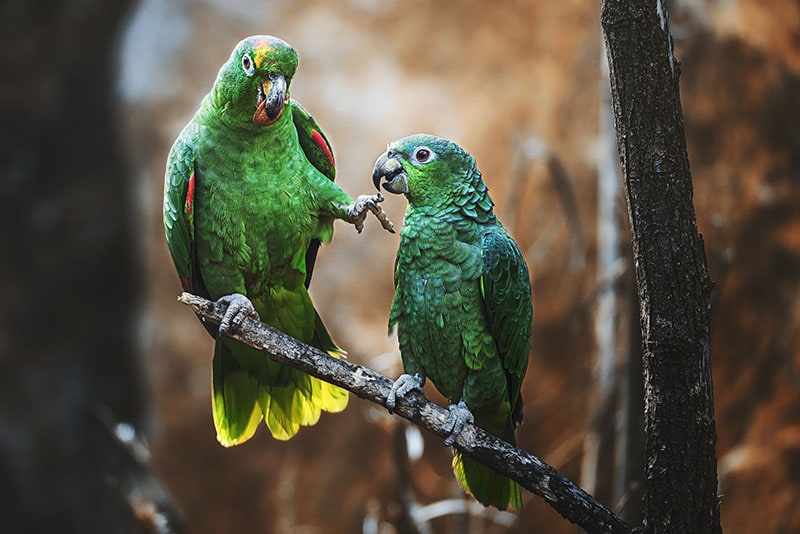
In general, parrots have significant sexual dimorphism: Males are easily recognizable since they sport colorful plumage to attract females, which often have duller plumage.
For toucans, it is more challenging to differentiate males from females because these birds do not exhibit sexual dimorphism in color. That said, the beaks of males are often longer than those of females.
Lifespan
One of the most significant differences between parrots and toucans is their longevity. Indeed, parrots are known for their exceptional lifespans, especially when kept as pets. Some species, like the African grey parrot, can live up to 80 years!
A toucan, even one kept in captivity, rarely exceeds the 30-year mark (though this is still impressive for a bird!).
Reproduction
Parrots lay eggs in nests perched on trees, cliffs, or the ground. Females lay two to five eggs, which they incubate alone or alternately with the male. After 17 to 30 days, the eggs hatch, and the female stays in the nest for a week or two until the first feathers appear, to allow the chicks not to suffer from the cold. Then, a few weeks later, they will take off.
For their part, toucans are the arboreal type—that is, they make their nests at the bottom of a hole dug in the rotten wood of a tree. The cavity, which limits passage to the bird, can be used for several years in a row.
If the lodge is too narrow, the toucan may enlarge it, but they cannot drill through the healthy wood to create one. The laying usually consists of two to four eggs, which the two adults take turns incubating. Upon hatching, the young are naked and blind, without the slightest down. They are fed on fruits and insects by the male and the female and grow in a few weeks. Their plumage appears after a month. Departure from the nest takes place between 47 and 49 days after hatching.
Is Keeping Toucans as Pets Different From Keeping Parrots?
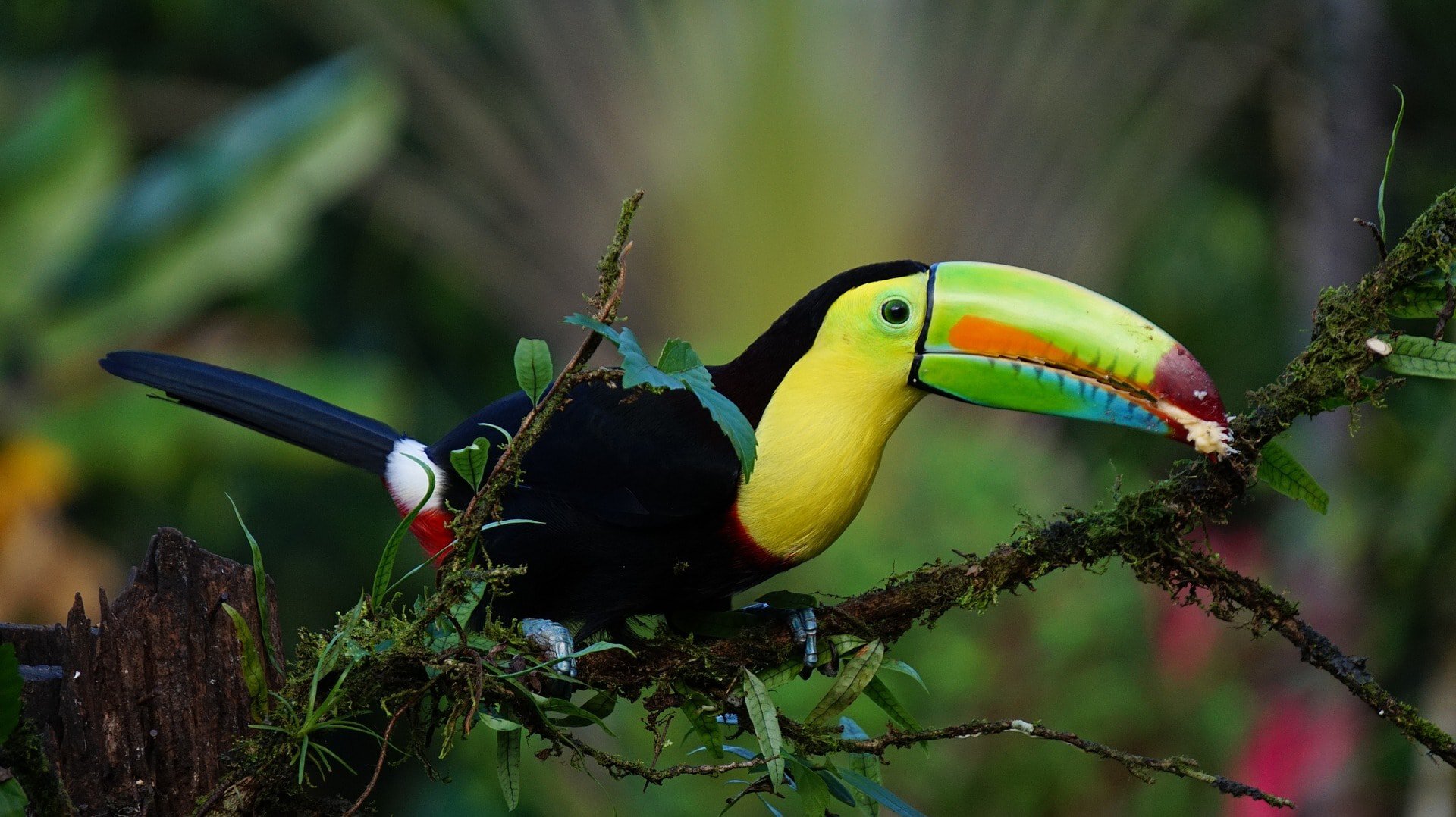
Unlike the different species of parrots, it is not common to see toucans kept as companion birds. Also, it is not legal in all states to have such an animal in your home. Not only are they much more expensive than parrots (some pet toucans sell for over $10,000!), but they are also more difficult to manage.
- They require a large cage with plenty of perches and branches to reproduce their natural rainforest habitat.
- They have fragile health.
- They are messy.
- They can’t talk.
- It is often necessary to hold a special permit to keep them in captivity.
- They tend to be aggressive and territorial toward other bird species.
- They are difficult to handle.
However, just like parrots, toucans are intelligent and playful, and once tamed, they enjoy human company, though they’re not as affectionate as parrots.
Final Thoughts
As magnificent representatives of the great Aves class, parrots and toucans share similar characteristics: They both have colorful and flamboyant plumage, are intelligent and playful, and can be kept in captivity (though this is more complicated in the case of the toucan). However, these bird species are not related and diverge primarily in habitat, geographic distribution, diet, reproduction, and sexual dimorphism.
Featured Image Credit by Pabloavanzini, Shutterstock
